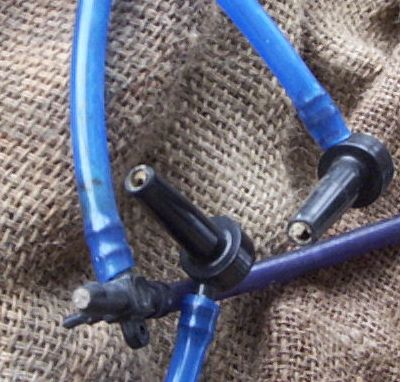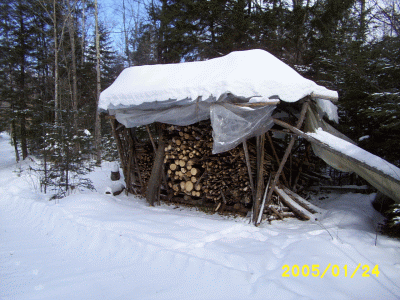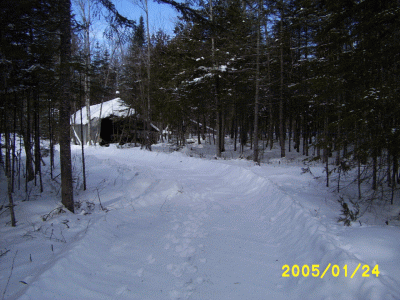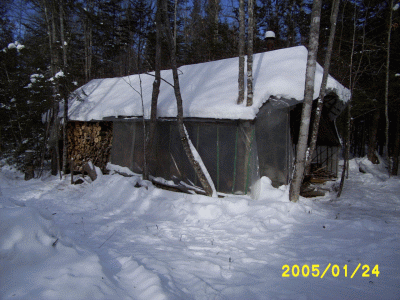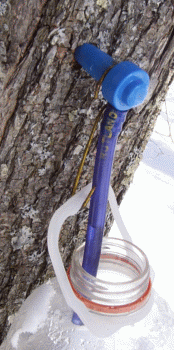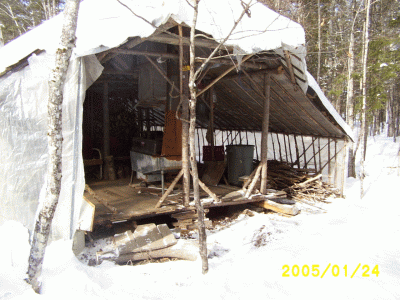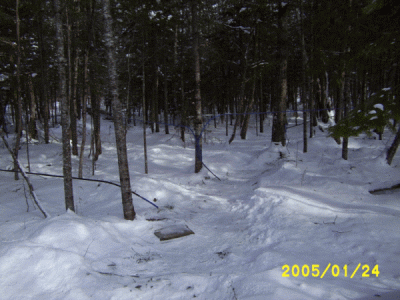OurMapleSyrup |
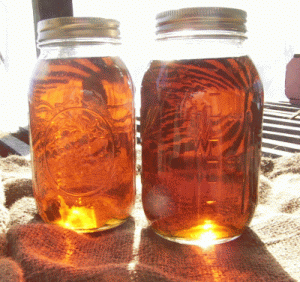 More maple pix of the 2005 season here. |
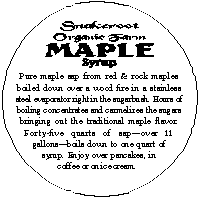
Available only at the farm and at our farmers’ markets
|
| How we got into sugaring.
In 1997, we began hanging a few jugs on some of the maple trees close to the house. The following year we went a little deeper into the woods and tapped more trees. By 1999 we were tapping over 50 trees and boiling sap into syrup became a very long process over the wood cookstove. We were able to stop buying syrup—we have a three-gallon-a-year habit—as we had plenty of our own syrup now for coffee, pancakes, and baking. In spite of all the work, having enough of our own syrup was a nice feeling. But carrying the jugs into the house and boiling the sap over a stove was a lot of work. So, in 2000, we made the leap and bought a real wood fired maple evaporator, built a crude sugar house in the woods, and tapped around 60 trees. We also began the move toward a tubing system that eliminated having to visit each tree twice a day to collect the sap. Now we began to produce enough syrup that we could give it away as holiday presents, have all we could use, and even have some left over by the time sugaring season began again. By 2001, we found quite a few more maples on a wooded hillside, so we ran tubing to those also. But since that tubing no longer ended at the old sugar house, we had to lug more than half our sap in 5 gallon jerry cans several hundred feet to the evaporator. And that meant we had to plow the woods road first or trudge through deep snow. In 2002 we ran a new tap line bringing our total taps to over 120. In addition we began moving toward building a new sugarhouse downhill from all the tapped maples, started running mainlines to the site, and began thinning the woods in preparation for tapping more trees. We also started selling our syrup by the quart at the farmers’ markets. We sold out by early September. By 2004 we had 250 taps; by 2005, 290. In 2011, we have over 400 taps out. As the smaller maple trees in the sugarbush grow large enough to tap, and as we clear out around ever more maple trees, each year we add a few more taps to the system. We tap any maple of sufficient diameter (11 inches and up), since we do not have an abundance of large rock (sugar) maples. Many of our taps are in red (swamp) maples, which yield a bit less sugar in the sap and therefor take longer to boil down, making a darker syrup. But we are not trying to make Fancy Grade A Light syrup. We are producing homegrown backyard dark maple syrup with a flavor you can taste, a flavor that brings you back for more whether you use it in coffee, on cereal or ice cream, in baking or on blueberry pancakes. How it works for a vegetable farmer to do sugaring. Sugaring, happening as it does in the late winter and early spring, dovetails nicely with other farm work. The greenhouse beds get planted on a sunny mid-winter day, but there is little else to do there but for an occassional watering. The maple season is almost over by the time we fire up the greenhouse stoves in late March. We begin tapping in early February in hopes of catching a few days of good sap run that generally occurs most seasons before the main run begins in ernest. Since the lines and taps are all still attached to the trees from last year, all that is required is to drill the new holes and pound in the taps. Then we keep an eye on the downhill end of the main line, waiting for the sap to begin flowing into the storage tanks at the sugarhouse on the first good sap day. March is the month we are boiling almost every day, often starting at dawn and continuing until late in the evening, when we don our headlamp for one last trip to the evaporator down in the dark woods, stoking the firebox with hardwood to keep the boil going into the wee hours. At the peak of the season the days are a continuous blur of stoking the fire, skimming the foam off the boiling sap, drawing off sap to be finished off indoors, filtering and bottling, hauling in more sap, refilling the evaporator, splitting wood and occassionally checking the lines for breaks or sags. And this is about when the great spring thaw begins, so the icing on the cake is that much of this is done in slush. There is usually a week or so of keeping three fires stoked simultaneously (house, greenhouse and evaporator), but by early April the maple work is slowing considerably. Now we are boiling only once every two or three days for less than half a day. This is the time for splitting and stacking next year’s sugar wood, and perhaps some thinning of the sugarbush. Finally at the end of the season the last big chore is to pull and plug the taps and flush the lines with a weak bleach solution. In November we are once again hauling seasoned wood to the sugarhouse, cutting, splitting and stacking it until the sugarhouse can hold no more. By late January we are listening to the weather in hopes of tapping out before the deep snow arrives. A word about jug systems Most casual or hobby sugaring enthusiasts start out with a jug system to collect maple sap. Some use gallon milk jugs, which, tho hard to clean, are readily available. Some hang these from the spile with a hook, others pierce the upper side of the jug with the spile. With a jug system, it is important to design things so that the jugs won’t blow off in the wind and yet the removal and reattachment of the jugs is a quick and efficient process, as you will find yourself doing it hundreds of times during a season. Some folks use a tubing tap and a 5 foot piece of tubing going through the top of a 5 gallon pail. We don’t like this system for two reasons. One is that there is a tendency to leave the sap too long if the sap isn’t running fast because it may take a few days to fill the pail. On warm spring days this allows the sap to sour, producing an inferior syrup. The other is that if the pail is full, only two can be carried, and this is awkward when the snow is deep. If these two problems could be avoided, I suppose this might be an acceptable system. Although we are now primarily on tubing, the few jugs we use are 1 gallon Gatoraid, Hi-C, or similar clear plastic juice bottles with a handy carrying handle, readily available in quantity from any redemption center. At first, the taps were whatever we could get a hold of, mostly modern steel spiles with hooks. Eventually we have moved to the same blue plastic spiles we use in the tubing collection system. On about thirty of the outlying trees we still hang jugs on these plastic spiles with hooks made from 6 inch pieces of coat-hanger wire with a loop on one end to go over the spile and a hook on the other to hold the jug handle. (See photo at right.) A short 4-6 inch scrap of tubing assures all the sap dripping from the tap goes into the jug. We removed the labels from the jugs and store them for a time when a jug handle finally breaks or when the dogs find that a blown off jug is a good chew toy. Then we simply tape the label back onto the jug and get 5¢ back at the redemption center. Visit us during sugaring On almost any sunny day in March, when the nights have been cold and the days are above freezing, the sap will be flowing and we will be boiling. Drive into the farm yard, and if you do not see anyone, honk your horn and we’ll soon be there. Wear your boots and warm clothing. The hike down to the sugar house is about a quarter mile over a plowed woods road through maple, spruce and hemlock woods. The maple collection lines extend uphill into the sugarbush about 1000 feet in five different directions. We do not advertise as part of Maine Maple Sunday, as we are a very small operation by industry standards and we would rather limit our tours to people who already know us or who would like to start sugaring at or near our scale. During sugaring I often like to take a break to talk to a visitor and walk the bush. Come watch the boil, lean your head over the evaporator, and smell the maple steam!
More pix of the 2005 season here! |
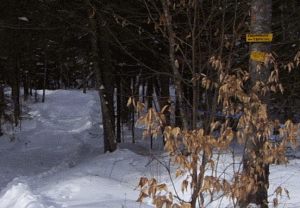 The Sugarhouse Trail.
On winter evenings, especially when there is a moon, making the trek out into the dark cold to the sugarhouse for the night’s last stoke, squeaking the snow on the trail with each step, I am reminded how glad I am that most of my jobs aren’t indoors. The dogs excitedly join me for a quick jaunt outside, follow along beside the moon-shadowed trail, patiently wait as I tend the evaporator fire, and just as eagerly follow me back to the house to jump onto the bed for the night. I ask myself, “What travel agency could offer this?” |
